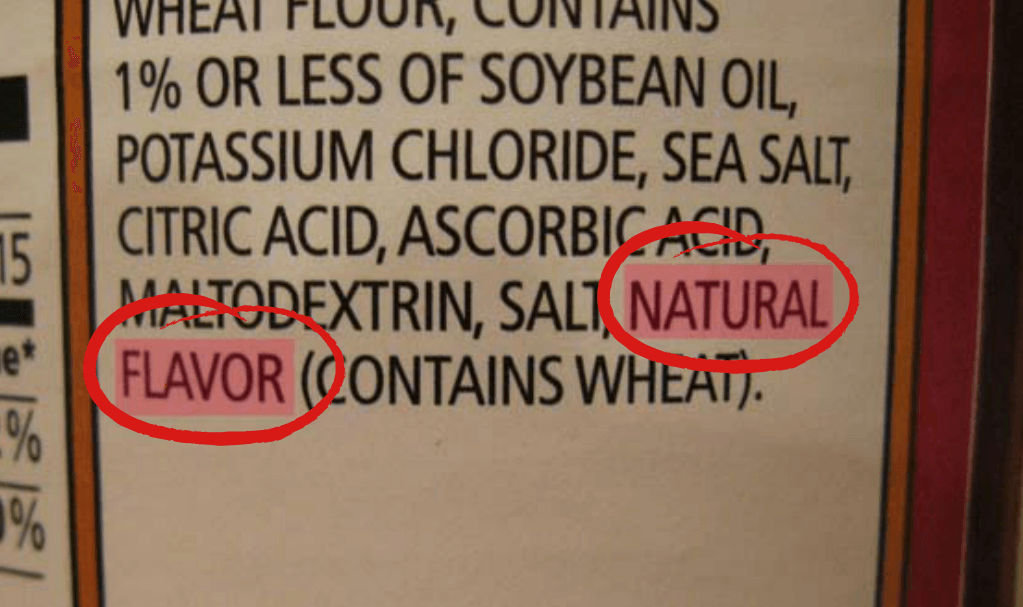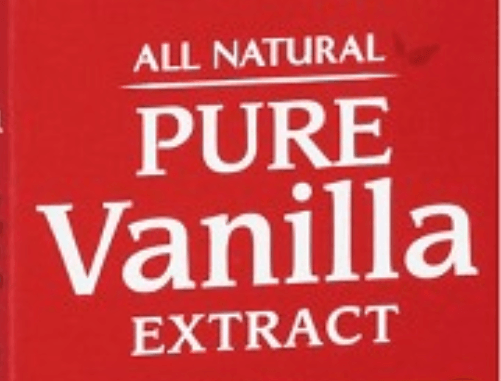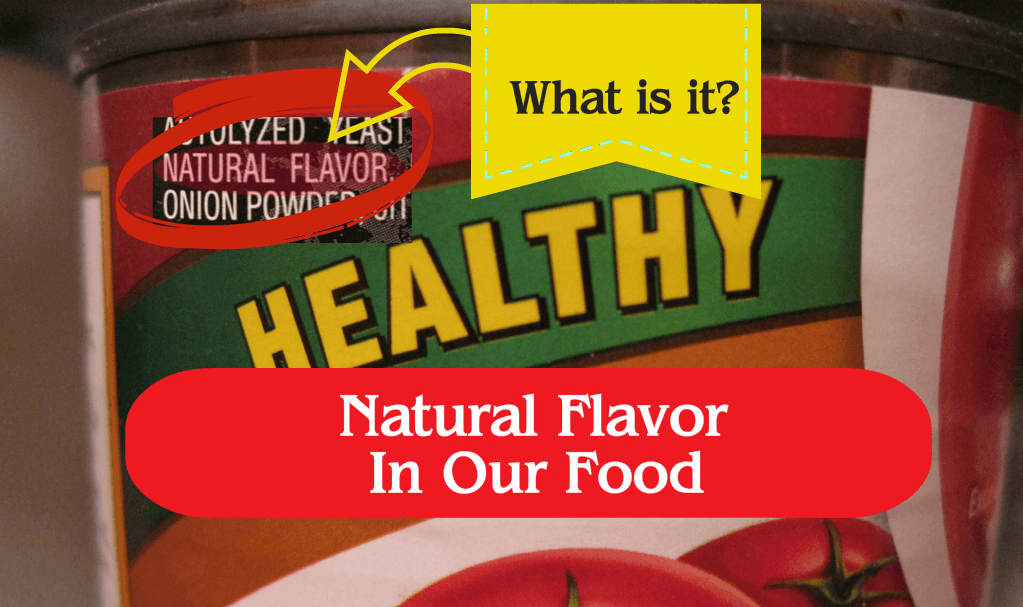Natural Flavors
Have you noticed the words “natural flavors” near the bottom of the food ingredient list of may food labels? What exactly is “natural flavors” and why is it in my food? It seems to be everywhere from canned soup, barbecue sauce, ice cream, and is prevalent in most junk foods. Suspicious.
Are these corporate food producers afraid to tell us what is “natural flavors”?
It seems to me like they are hiding something. Let’s dive in and find out.
Natural Flavors Defined by FDA
The term “Natural Flavors” is defined by the Food and Drug Administration (FDA):
A material is deemed “natural” when the flavoring or substance is derived from a product such as a spice, fruit or fruit juice, vegetable or vegetable juice, edible yeast, herb, bark, bud, root, leaf of similar plant material, meat, seafood, poultry, eggs, dairy products, or fermentation products, or from a group of materials that the FDA recognizes as natural starting materials. Its’ significant function in food is flavoring rather than nutritional.
There is a long list of processes that can be applied to derive the flavor while still allowing it to be called “natural” flavors .
The processes include:
distillation extraction roasting heating
enzymolysis hydrolysis fermentation
The US definition of natural is based upon how the flavor is derived from the natural source, and not the process used.
Unlike the US, the EU has a slightly different definition of “natural” and requires a natural substance be identical to that found in nature and not altered in any way.

Vanilla Extract
A “natural” vanilla flavoring can be extracted through distillation and fermentation.

Vanilla flavoring extracted via the fermentation processes can use ferulic acid as a starting material allows for the extraction of the vanillin from a variety of natural sources including coffee beans, apple and orange pips, and wheat bran.
Vanilla bean flavor doesn’t have to be extracted from the vanilla plant ironically. The “natural” vanilla flavoring can be derived from other materials that have the chemical constituents similar to the taste of vanilla, hence natural vanilla flavoring can be used in the label even though there is no actual vanilla bean in it.
If the vanilla is produced through fermentation from another source, for example guaiacol, which the FDA does not recognize as a natural starting material, it cannot be labeled as natural. It would thus be labeled as artificial flavoring.
Guaiacol is an oily yellow liquid with a penetrating odor, obtained by distilling wood tar.
Yes, that may be in your artificially flavored vanilla.
Natural flavorings are used to enhance the flavor of the food in some way. Unfortunately the FDA does not require companies to list what those ingredients that the “natural flavorings” consist of.
A trade secret perhaps?
Or too scary for consumers to know… The FDA is willing to let corporate food producers to use the “natural” label so long as the food does not contain any added colors, artificial flavors, or synthetic substances and it falls within the approved “Generally Recognized As Safe” list.
Generally Recognized As Safe by the FDA Designation
Substances considered “Generally Recognized As Safe” (GRAS) is a FDA designation that assumes a food additive or flavor ingredient is considered safe by experts within a specific range of use.
Genetically Modified Organism (GMO) made it through the FDA approval without in depth testing since it was considered a GRAS.
A soybean is a soybean, right?
Wrong – if you are not up on the GMO scandal, try Jeffery Smith’s book Seeds of Deception!
Same with the growth hormone that are injected into cows that make them produce more milk and is linked to breast and prostate cancer in humans.
So GRAS designation does not necessarily give us the warm fuzzies when it comes to food safety.
“Natural flavors” can still be GMO derived.”
The FDA also indicates that in order for a substance to maintain its GRAS designation, it must be produced in accordance with Good Manufacturing Practice (GMP).
The Flavor & Extract Manufacturers Association (FEMA) maintains a list of over 2,500 ingredients and substances that are classified as GRAS. Here’s the list.
Since 2011, food and flavoring facilities must now also comply with Hazard Analysis & Critical Control Points (HACCP) procedures.
HACCP is a supply chain system that addresses food and flavor ingredient safety through the control of biological, chemical, and physical hazards all the way from raw material production, through procurement and handling, to manufacturing, distribution and consumption of the finished product.
Maybe this make us feel a bit better knowing there shouldn’t be hazardous waste in our food.
“Natural Flavors”
Still confused on what Natural Flavors Are?
Not surprising.
It’s a generic term for any number of (naturally derived) chemicals produced in a laboratory to enhance the taste of the food you are consuming.
It’s all about the chemistry that makes the flavors.
Corporate food producers have food science laboratories where employees process, extract, and ferment naturally derived materials who have the correct chemical constituents as flavors we are familiar with.
Vanilla flavoring coming from coffee beans, apple and orange pips, and wheat bran is a good example.
Raspberry flavoring in ice cream may come from orris root.
“Flavor Enhancers”
A natural flavoring can also be a flavor enhancer.
The most infamous one is monosodium glutamate (MSG).
While MSG is now required by the FDA to be disclosed on the food label, over 40 other MSG-containing ingredients are not.
This includes the ingredients “stock” and “broth,” both of which can be used without naming what they are actually made of, which may or may not include MSG.
MGS and its bi-products made it into the GRAS and thus is considered a “natural flavor”.
Examples of hidden or misleading labels that contain MSG include:
- ‘hydrolyzed vegetable protein’
- ‘vegetable protein’
- ‘natural flavorings’ and
- ‘spices’
Each of these may contain from 12 per cent to 40 per cent MSG.
“Food Addictions, MSG and Disease
Glutamate, as monosodium glutamate (MSG), is a flavor enhancer that excites our taste buds and can make bland food taste good.
It is also a known toxin, called an “excitotoxin”.
Excitotoxins overexcite your cells literally until they die or are damaged causing “injury” and “incapacitating” you with disease.
These excitotoxins are some of the chemicals that cause your taste buds to experience irresistibility towards certain foods, and the fast food industry has capitalized it.
By inserting “natural flavors” that contain MSG-byproducts the results generally lead to consuming or over-consuming their product.
You can’t eat just one potato chip…
When consumed over time, excitotoxins can cause neurodegenerative diseases including:
- ALS/ Lou Gehrig’s disease
- Parkinson’s and
- Alzheimer’s
Other diseases including obesity, migraines, fatigue and depression are linked to consumption of glutamate over time.
Vegetarians and Vegans and Natural Foods
If you are a vegetarian or vegan be aware that natural flavorings can be animal derived.
Meat, fish, fowl, eggs, honey and dairy all can be used to produce flavor enhancer and flavor equivalent ingredients.
Here are a few natural flavors that are derived from animals:
Castoreum:
Most famous for enhancing the flavor of raspberry, it’s name is derived from the animal it originates from: beaver, it scientific name begins with Castor.
Castoreum is the yellowish secretion of the castor sac which is, in combination with the beaver’s urine, used during scent marking of territory. Beaver butt gland.
Here are common products that it is added to:
- alcoholic beverages,
- baked goods,
- frozen dairy,
- chewing gum,
- candy,
- beverages,
- pudding,
- gelatin,
- ice cream,
- vanilla flavoring and
- raspberry flavored food.
Below is a table of reported concentrations of Castoreum in food.
Reported Uses Castoreum PPM (parts per million) (Fema 1994):
| Food Category | Usual | Max |
| Alcoholic Beverages | 79.59 | 93.69 |
| Baked Goods | 62.28 | 68.47 |
| Gelatins, Puddings | 43.58 | 47.34 |
| Soft Candy | 37.28 | 44.10 |
| Frozen Dairy | 24.39 | 26.26 |
| Nonalcoholic Beverages | 24.21 | 29.77 |
| Hard Candy | 24.17 | 24.17 |
| Chewing Gum | 18.60 | 42.09 |
Cochineal and Carmine:
Natural food colorings that include orange and red can be made from the bodies of a scaly female insect. It is used as a color additive in applesauce, baked goods (red velvet cake) and some spices.
In 2009 the Food and Drug Administration required that these ingredients be specifically labeled when used in food and cosmetics so look for these two natural ingredients if you want to avoid animal based products.
Confectioner’s glaze:
This red dye, or Shellac, is a coating or glaze derived from the hardened, resinous material secreted by the lac insect, much like honey from a bee. Shellac in its raw form is known as “lac resin,” along with lac wax and lac dye.
The female secretes the sticky substance to make a protective shell to lay her eggs.
Doesn’t sound so appetizing now, does it?
Confectioner’s glaze is used in products such as candies (Hershey’s Milk Duds, for example), cosmetics and chewing gum.
Bottom line if you are a vegetarian:
Either make these foods from scratch, buy from a local producer where you can find out these ingredients, or avoid them entirely. The same goes for all of us, “natural flavors” may or may not contain harmful substances.
Unless we call up the food manufacturer (and they are willing to give an answer) for every product that has this label (or other misleading labels), we have no way of knowing its source or how it is made.
The best option is to read food labels, ask questions, and avoid those foods that contain this suspicious designation.




